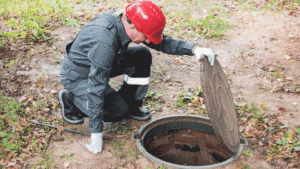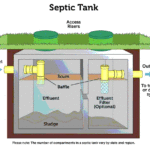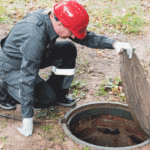Introduction

Preparing for a Septic Tank Inspection
Before you begin inspecting your septic tank, there are several steps to prepare:
- Clear the area around the tank: Remove any debris, vegetation, or obstacles that may hinder access to the tank.
- Gather personal protective equipment (PPE): Ensure you have gloves, protective eyewear, and waterproof boots to protect yourself during the inspection.
- Review any available documentation: Locate your septic system’s installation records, maintenance history, and any other relevant information.
- Notify household members: Inform everyone in the house about the inspection to minimize water usage during the process.
Tools and Equipment Needed for Septic Tank Inspection
To inspect your septic tank effectively, you’ll need the following tools and equipment:
- Flashlight: To illuminate dark spaces within the tank.
- Gloves, protective eyewear, and waterproof boots: For personal safety and protection.
- Sludge judge: A long, graduated pole used to measure the depth of sludge in the tank.
- Shovel or soil probe: To dig around the tank and inspect the drainfield.
- Camera: To document the inspection process and any issues found.
- Notebook and pen: To record measurements and observations.
Step-by-Step Guide to Inspecting Your Septic Tank
Follow these steps to inspect your septic tank:
- Locate the tank: Use your installation records or local utility maps to find the tank’s location.
- Uncover the access ports: Remove any dirt or debris covering the tank’s access ports.
- Inspect the tank’s structural integrity: Look for cracks, holes, or other signs of damage in the tank’s walls and lid.
- Measure the sludge depth: Insert the sludge judge into the tank and record the depth of the sludge and scum layers.
- Check the baffles: Inspect the inlet and outlet baffles for damage, blockages, or signs of deterioration.
- Examine the drainfield: Dig around the drainfield to ensure it’s not saturated or emitting foul odors.
- Record your findings: Document all observations, measurements, and issues discovered during the inspection.
- Replace the access port covers: Ensure all covers are securely fastened after the inspection.
Common Septic Tank Issues to Look Out For
During your inspection, be aware of the following common issues:
- Cracks or holes in the tank
- Blockages in the inlet or outlet baffles
- Excessive sludge or scum accumulation
- Standing water or foul odors in the drainfield
- Signs of backups or overflows
- Tree roots infiltrating the system
- Corroded or damaged pipes
When to Call a Professional for Septic Tank Inspection
While you can perform a basic septic tank inspection yourself, there are situations when it’s best to call a professional:
- When the tank is not easily accessible
- When major issues are suspected
- When required by local regulations
- If you’re uncomfortable performing the inspection yourself
- For routine professional inspections every 3-5 years
Septic Tank Inspection Frequently Asked Questions
Q: How often should I inspect my septic tank?
A: Homeowners should inspect their septic tanks annually and have them pumped every 3-5 years, depending on usage and tank size.
Q: How much does a professional septic tank inspection cost?
A: Professional inspection costs vary but typically range from $100 to $300. Factors affecting the cost include location, tank size, and the extent of the inspection.
Q: What are the consequences of neglecting regular septic tank inspections?
A: Neglecting inspections can lead to costly repairs, tank failures, environmental damage, and potential health hazards. Regular maintenance can help avoid these issues and extend the life of your septic system.
Conclusion
By following this comprehensive guide, you’ll be well-equipped to inspect your septic tank, ensuring its proper function and longevity. Remember, regular inspections and maintenance are key to preventing expensive repairs and maintaining a healthy, safe living environment. If you’re ever in doubt about the condition of your septic system or your ability to inspect it properly, don’t hesitate to contact a professional for assistance.






